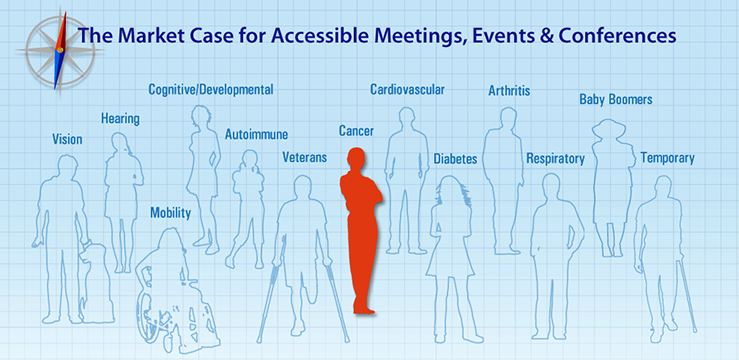The Market Case for Accessible Events, Meetings and Conferences
In fact, many Americans who would be best served by a fully accessible meeting, event, or conference environment may not identify their needs as representative of a disability. This is especially true today, when there is a ground swell of individuals with a wide range of emerging functional needs that will force businesses to meet them where they are, or they will find another vendor who can. In the age of social media, where more and more people share their experiences (the good and the not so good) in real time, businesses and planners who can ride the wave of positive, customer-centric approaches for their offerings will reap economic benefits.
Scroll through the population notes below and see if you don't find yourself one degree (or less) from someone who may benefit from the promising practices presented in this online guide.

Americans with Disabilities: 57.6 Million
According to the U.S. Census, 57.6 million Americans reported having a disability in the 2010 American Community Survey (published July 2012). This number is just a fraction of individuals who would be better served by meetings and conferences that offered accessibility accommodations.
Vision: 20.6 Million
According to the 2012 National Health Interview Survey (NHIS) Preliminary Report, an estimated 20.6 million adult Americans (or nearly 10% of all adult Americans) either "have trouble" seeing, even when wearing glasses or contact lenses, or are blind or unable to see at all (source: the American Foundation for the Blind).
Hearing: 30 Million
One in eight people in the United States (13%) aged 12 years or older has hearing loss in both ears, based on standard hearing examinations (National Institute on Deafness and other Communication Disorders).
Mobility: 8 Million
According to the University of Kentucky Human Development Institute, there are approximately 8 million Americans who have some type of mobility impairment that necessitates the use of adaptive equipment such as a cane, crutches, walker, wheelchair, or scooter.
Cognitive/Developmental: 60 Million
There are 60 million Americans nationwide with learning and attention issues (National Center for Learning Disabilities). The Journal of Pediatrics reports that one in six, or about 15%, of children aged 3 through 17 years have one or more developmental disabilities. The Centers for Disease Control and Prevention (CDC) Autism and Developmental Disabilities Monitoring (ADDM) Network reports that 1 in every 68 children in the U.S. has autism spectrum disorder (ASD).
Autoimmune: 23.5 Million
The National Institutes of Health (NIH) estimate there are up to 23.5 million Americans with autoimmune disorders, including multiple sclerosis, lupus, rheumatoid arthritis, and more.
Cancer: 1.6 Million
In 2014, an estimated 1,665,540 new cancer cases were diagnosed (American Cancer Society). In the U.S., 14.5 million children and adults with a history of cancer were alive on January 1, 2014.
Veterans: 2.3 Million
Approximately 20% (2,313,600 out of 11,462,900) of non-institutionalized civilian veterans aged 21 to 64 years reported having a service-connected disability in the United States in 2012.
Cardiovascular: 80 Million
An estimated 80 million Americans have one or more types of heart disease (The Heart Foundation).
Diabetes: 29.1 Million
The CDC reports 29.1 million people with diabetes living in the U.S.
Arthritis: 51.8 Million
The CDC reports 51.8 million non-institutionalized adults with diagnosed arthritis (2012).
Respiratory: 19.6 Million
The CDC reports 6.8 million adults diagnosed with Chronic Obstructive Pulmonary Disease (COPD) in the past year, 8.7 million with chronic bronchitis, and 4.1 million with emphysema.
Baby Boomers: 77 Million
CNN reports 77 million Americans are part of the aging “Baby Boom” generation (born between 1946 and 1964). They represent roughly 24.3% of the total population.
Temporary
Have you ever broken a limb? Recovered from surgery? Given birth? Experienced a perinatal condition such as high blood pressure or gestational diabetes? Been in a car wreck? Picture yourself here!


User Comments/Questions
Add Comment/Question